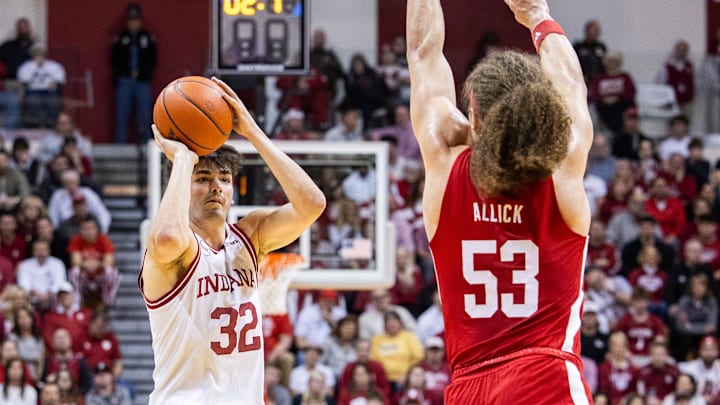It has been a far-from-ideal season for the Indiana Men's Basketball team. Currently sitting at a 14-13 overall record and 6-10 in the Big Ten, the Hoosiers have failed to come close to high offseason expectations. One of Indiana's most significant weaknesses has been 3-point shooting—let's look at how this has affected the Hoosiers throughout the season.
It is nearly impossible to win basketball games nowadays without making shots from three, and the Hoosiers have been a prime example. On Saturday, Indiana lost to Penn State despite a whopping 50 points in the paint. They made just two of 15 attempts from three, a big reason for the defeat.
Mike Woodson's squad does not take many threes, nor do they hit many. Indiana makes just 5.0 of their 15.8 shots from behind the arc per game, which ranks 342nd and 341st in the country, respectively. This puts them at a season average of 31.5% from three, 228th in the country. The Hoosiers are 12th in the Big Ten in three-point percentage and dead last in three-point field goals made.
Let's take a look at Indiana's three-point shooting on an individual level:
- After a very promising 46.2% from behind the arc during his junior year, Trey Galloway has significantly regressed to 27.2% (25-92).
- Mackenzie Mgbako's smooth shooting stroke and high release excited Hoosier fans all offseason, but he has hit just 31.6% (37-117) of his threes since arriving in Bloomington.
- Gabe Cupps and CJ Gunn have each hit some clutch threes this season but are shooting just 34.4% (11-32) and 33.0% (14-41), respectively.
- Although Anthony Leal has shot 40.0%, he has made just six threes on the season (6-15).
- In the 14 games that Xavier Johnson has played, he has shot 34.8% (8-23).
- Malik Reneau has made just one three-pointer in his last 11 games after making 12 in his first 16 games (32.5%, 13/40 on the year).
- Kel'el Ware has shot a solid 41.9% (13-31) from behind the arc but only takes about one per game.
- Anthony Walker has made just two of his 16 attempts from three, effectively putting him at 12.5%.
It's safe to say that the Hoosiers haven't quite had a "go-to" guy from behind the arc.
Last season, Miller Kopp shot the three-ball at an efficient 44.4% on 4.1 attempts per game. This threat from behind the arc allowed for a much more complete offense and spacing on the floor. Indiana's opponents often had no choice but to double-team Trayce Jackson-Davis, often leaving Kopp open for a corner or elbow three.
This year, a knockdown shooter like Kopp would unclog the interior on offense and allow more room for Ware and Reneau to work. Instead, opposing teams have no problem double-teaming in the post and leaving Indiana's shooters open from three.
And can you blame them? With Indiana guards shooting so poorly from three, teams are willing to take their chances and leave them open to double.
Whether it's a mental issue or a problem rooted in the offensive scheme, it is hard to believe that there is a quick solution to this shooting issue. Indiana has plenty of talent and is getting plenty of good looks, but the shots are not falling from deep. With this being a common theme for the entire season, it seems very unlikely that the Hoosiers' three-point shooting will pick up for the rest of the season.
Is the solution to shoot even fewer threes and continue to pound the ball inside? Is it to shoot MORE threes to give players more looks and attempts to get in rhythm? The answer is anyone’s guess.
The good news? Liam McNeeley is on his way to IU for the 2024-25 season, and three-point shooting is his specialty.
"McNeeley is a sturdy, strong combo forward with big-time three-point shooting ability," an NBA scout said. "He's got an easy, smooth release on his jumper and is deadly accurate from the outside."
Help from beyond the arc is on the way, but Hoosier fans can only hope and pray that McNeeley isn't another highly-rated recruit whose three-point percentage plummets when he arrives in Bloomington.
